Nokia TMR880 User Manual
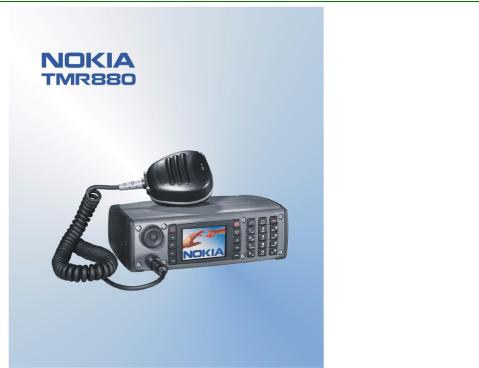
User Guide
9355653
Issue 3
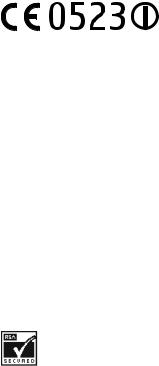
DECLARATION OF CONFORMITY
We, NOKIA CORPORATION declare under our sole responsibility that the product Nokia TMR880 is in conformity with the
provisions of the following Council Directive:1999/5/EC. A copy of the Declaration of Conformity can be found at http://www.nokia.com/phones/declaration_of_conformity/.
Copyright © 2003-2005 Nokia. All rights reserved.
Reproduction, transfer, distribution or storage of part or all of the contents in this document in any form without the prior written permission of Nokia is prohibited.
Nokia and Nokia Connecting People are registered trademarks of Nokia Corporation. Other product and company names mentioned herein may be trademarks or tradenames of their respective owners.
Nokia tune is a sound mark of Nokia Corporation.
US Patent No 5818437 and other pending patents. T9 text input software Copyright (C) 1997-2005. Tegic Communications, Inc. All rights reserved.
Includes RSA BSAFE cryptographic or security protocol software from RSA Security.
Nokia operates a policy of continuous development. Nokia reserves the right to make changes and improvements to any of the products described in this document without prior notice.
Under no circumstances shall Nokia be responsible for any loss of data or income or any special, incidental, consequential or indirect damages howsoever caused.
The contents of this document are provided "as is". Except as required by applicable law, no warranties of any kind, either express or implied, including, but not limited to, the implied warranties of

merchantability and fitness for a particular purpose, are made in relation to the accuracy, reliability or contents of this document. Nokia reserves the right to revise this document or withdraw it at any time without prior notice.
The availability of particular products may vary by region. Please check with the Nokia dealer nearest to you.
El uso y el funcionamiento de este dispositivo requieren licencia.
Si desea obtener información detallada, póngase en contacto con las autoridades competentes en materia de frecuencia de su país.
Denne enhed må kun betjenes, hvis der er givet tilladelse hertil. Kontakt den lokale frekvensmyndighed for at få yderligere oplysninger.
Für die Verwendung dieses Geräts ist eine Funklizenz erforderlich. Weitere Informationen erhalten Sie in Deutschland bei der für ihren Wohnort zuständigen Außenstelle der Regulierungsbehörde für Telekommunikation und Post.
The use and operation of this device is subject to permission: for details contact your local frequency authority.
L'utilisation et l'exploitation de cet appareil sont soumises à autorisation : pour plus d'informations, prenez contact avec l'autorité locale compétente en matière de fréquences.
L'utilizzo di questo dispositivo deve essere autorizzato: per informazioni contattare la locale autorità per l'assegnazione delle frequenze.
Het gebruik van dit apparaat is alleen toegestaan als u daarvoor toestemming hebt gekregen. Neem contact op met de plaatselijke instantie voor meer informatie.
A utilização e funcionamento deste aparelho estão sujeitos a autorização: para mais informações, contacte as entidades locais responsáveis pela atribuição de frequências.
Tämän tuotteen käyttö on luvanvaraista. Ota yhteys paikalliseen taajuusviranomaiseen.
Användning av denna utrustning kan kräva tillstånd. Kontakta den lokala postoch telemyndigheten.
Гйб фз чсЮуз кбй фз лейфпхсгЯб бхфЮт фзт ухукехЮт брбйфеЯфбй чпсЮгзуз бдеЯбт: гйб лерфпмЭсейет ерйкпйнщнЮпфе ме фзн бсмьдйб фпрйкЮ бсчЮ гйб фйт ухчньфзфет.
Pou¾ití a provoz tohoto zaøízení není mo¾ný bez povolení: dal¹í informace získáte u místního telekomunikaèního úøadu.
Käesoleva seadme kasutamine ja töötamine on seotud vastavate lubadega: teabe saamiseks pöörduge kohalikku ametkonda, mis tegeleb raadiosageduste haldusega.
A készülék használata és üzemeltetése engedélyhez kötött. A részletekrõl érdeklõdjön a helyi frekvenciahasználat-szabályozó hatóságnál.
Naudotis ¹iuo prietaisu galima tik gavus leidim±. I¹samesnìs informacijos teiraukitìs vietinìje ry¹iù reguliavimo tarnyboje.
©ïs ierïces lieto¹anai un ekspluatàcijai nepiecie¹ama at¶auja: lai iegþtu sïkàku informàciju, sazinieties ar vietºjo frekvenèu regulº¹anas pàrvaldi.
L-uzu u t-thaddim ta' dan l-apparat jenhtiegu permess. Ghal aktar taghrif irrikorri ghand l-Awtorità Maltija ghall-Komunikazzjonijiet.
U¿ytkowanie i obs³uga tego urz±dzenia wymaga zezwolenia. Szczegó³owe informacje na ten temat mo¿na uzyskaæ od lokalnych organów zajmuj±cych siê kontrol± czêstotliwo¶ci radiowych.
Na pou¾ívanie a prevádzku tohto zariadenia sa vy¾aduje povolenie. Podrobné informácie získate od miestneho rádiotelekomunikaèného úradu.
Za uporabo te naprave morate imeti ustrezno dovoljenje; dodatne informacije so na voljo na Agenciji za telekomunikacije in radiodifuzijo Republike Slovenije.

Quick guide
These pages give you some tips for using your Nokia TMR880 radio. For more detailed information, read through this user’s guide.
■ Call functions
Selecting a folder
Talk groups are divided into folders. To select a folder, press  , scroll to the desired folder and press Select.
, scroll to the desired folder and press Select.
Selecting a talk group
Turn the group selector until you reach the desired group.
Making a group call to your selected group
Once you have set your selected group and its name is displayed in standby mode, press and hold the PTT key.
Responding to a group call
Press and hold the PTT key. You can start speaking when a short tone is played.
Making an express call
Key in a TETRA number and press and hold the PTT key. You can start speaking when a short tone is played.
Responding to an express call
Press and hold the PTT key. You can start speaking when a short tone is played.
Copyright © 2005 Nokia. All rights reserved. |
6 |

Making a phone call |
|
|
Key in the area code and phone number and press |
. The area code is not |
|
required for TETRA numbers. Scroll to Private, Abbr. number, Phone or |
||
ext. (see also Making a phone call on page 62) and press |
. |
Office |
|
|
|
Answering a phone call
Press  when a ringing tone is played.
when a ringing tone is played.
■ Direct mode
Activating direct mode
To quickly activate direct mode, press  , scroll to Direct mode and press
, scroll to Direct mode and press
Select.
Selecting a channel and a group
Turn the group selector until you reach the desired channel. Use the back key to select groups. For details, see Selecting direct mode channels and groups on page 68
.
■ Using the keys
Adjusting the volume
The volume keys are on the right side of the display. Press  to increase the volume and
to increase the volume and  to decrease the volume. See also Muting external loudspeakers on page
to decrease the volume. See also Muting external loudspeakers on page
Using the fast menu key
33 |
|
|
. |
Copyright © 2005 Nokia. All rights reserved. |
7 |

Press |
to access the fast menu. In the fast menu, scroll with |
and |
|||
|
or by pressing |
and select items by pressing and holding |
or |
||
pressing Select. See Fast menu on page . |
|
|
|
||
Using the duty key |
|
|
|
|
|
You can set the duty key |
to either make a call to the home group, to start a |
||||
call to the selected group’s dispatcher or to send a callback request to the |
|||||
selected group’s address. See 44 |
on page |
. |
|
||
■ Basic menu functions
Entering a menu |
or |
103 |
|
Press Menu, scroll with |
to the desired menu function |
||
and press Select. |
|
|
|
Exiting a menu |
|
|
|
Press |
to exit a menu function without changing its settings |
||
and return to standby mode. See also |
on page 54 |
||
and page 70. |
|
|
|
■ Other functions |
|
|
Duty key setting |
|
|
Locking and unlocking the keypad |
|
|
To lock the keypad keys except for the volume keys, , |
and the red |
|
function key , press Menu and then |
. To lock all the keys of the radio |
|
Copyright © 2005 Nokia. All rights reserved. |
8 |
Muting the call temporarily

except the volume keys, the red function key |
and the back key, press Menu |
|
and then press and hold |
. |
|
To unlock the keys, press Unlock and then |
quickly. |
|
Searching for names in the contacts directory
To find names, press Contacts, select Search name, and pressSearch
, key in the first characters of the
.
Copyright © 2005 Nokia. All rights reserved. |
9 |

Contents |
|
Quick guide........................................................................................................... |
6 |
Contents............................................................................................................. |
10 |
FOR YOUR SAFETY ............................................................................................ |
17 |
General information.......................................................................................... |
20 |
Access codes .............................................................................................................................................. |
20 |
PIN code (4 digits) ................................................................................................................................ |
20 |
Security code (5 digits)........................................................................................................................ |
20 |
Conventions used in this guide ............................................................................................................ |
20 |
Modes of operation.................................................................................................................................. |
21 |
Shared memory ......................................................................................................................................... |
21 |
Transmission barring................................................................................................................................ |
22 |
Network selection .................................................................................................................................... |
23 |
Special features......................................................................................................................................... |
24 |
Control unit................................................................................................................................................ |
24 |
1. Getting started .............................................................................................. |
25 |
Switching the radio on and off ............................................................................................................ |
25 |
Ignition sense ................................................................................................................. |
|
Locking the keys (Keyguard).................................................................................................................. |
26 |
2. Your radio ...................................................................................................... |
27 |
Types of calls.............................................................................................................................................. |
28 |
Red key calls........................................................................................................................................... |
29 |
Group selector and back key ................................................................................................................. |
30 |
Copyright © 2005 Nokia. All rights reserved. |
10 |
The PTT (Push-To-Talk) key .................................................................................................................... |
30 |
Speaker microphone ................................................................................................................................ |
32 |
Duty key and fast menu key.................................................................................................................. |
33 |
Light indicator ........................................................................................................................................... |
33 |
Muting external loudspeakers .............................................................................................................. |
33 |
Display indicators ..................................................................................................................................... |
34 |
Standby mode ........................................................................................................................................ |
34 |
Call indicators ........................................................................................................................................ |
36 |
Guide messages......................................................................................................................................... |
37 |
3. Using your radio ............................................................................................ |
39 |
Accessing a menu function ................................................................................................................... |
39 |
Accessing a menu function by scrolling......................................................................................... |
39 |
Accessing a menu function by its shortcut number ................................................................... |
39 |
List of menu functions ............................................................................................................................ |
41 |
Fast menu ................................................................................................................................................... |
44 |
Activating a fast menu item .............................................................................................................. |
44 |
Voice feedback ................................................................................................................. |
|
4. Group calls ..................................................................................................... |
46 |
Group call basics....................................................................................................................................... |
46 |
Folders ...................................................................................................................................................... |
47 |
Home group ............................................................................................................................................ |
47 |
Dynamic talk groups ............................................................................................................................ |
48 |
Starting group communication ............................................................................................................ |
49 |
Switching group calls on and off ..................................................................................................... |
49 |
Selecting a folder.................................................................................................................................. |
49 |
Selecting a talk group.......................................................................................................................... |
50 |
Scanning settings.................................................................................................................................. |
51 |
PTT key use.............................................................................................................................................. |
51 |
Copyright © 2005 Nokia. All rights reserved. |
11 |
Accessing the group list in standby mode ........................................................................................ |
52 |
Receiving a group call............................................................................................................................. |
52 |
Responding to a group call ................................................................................................................ |
53 |
Voice override......................................................................................................................................... |
53 |
Muting the call temporarily............................................................................................................... |
54 |
Making a group call................................................................................................................................. |
54 |
Making a call to the selected talk group ....................................................................................... |
54 |
Making a call to a scanned talk group ........................................................................................... |
54 |
Calling a talk group’s dispatcher ...................................................................................................... |
55 |
Talk groups (Menu 4)............................................................................................................................... |
55 |
Edit folder: .............................................................................................................................................. |
56 |
View background folder ...................................................................................................................... |
57 |
Group journal .................................................................................................................. |
|
5. Express calls................................................................................................... |
59 |
Making an express call ........................................................................................................................... |
59 |
Reusing a number ................................................................................................................................. |
60 |
Making an express call to an abbreviated TETRA number ........................................................ |
60 |
Last number redial ................................................................................................................................ |
60 |
Speed dialling a phone number ........................................................................................................ |
61 |
Receiving an express call ....................................................................................................................... |
61 |
Responding to an express call........................................................................................................... |
61 |
Rejecting an express call .................................................................................................................... |
61 |
6. Phone calls ..................................................................................................... |
62 |
Making a phone call ................................................................................................................................ |
62 |
Making a phone call to an abbreviated TETRA number ............................................................. |
63 |
Last number redial ................................................................................................................................ |
63 |
International phone calls.................................................................................................................... |
64 |
In-call options........................................................................................................................................ |
64 |
Copyright © 2005 Nokia. All rights reserved. |
12 |
....................... 58
Speed dialling a phone number............................................................................................................ |
65 |
Answering a phone call .......................................................................................................................... |
65 |
Muting the ringing tone ..................................................................................................................... |
65 |
Rejecting a phone call ......................................................................................................................... |
65 |
7. Direct mode ................................................................................................... |
66 |
Direct mode basics ................................................................................................................................... |
66 |
Using direct mode .................................................................................................................................... |
67 |
Activating direct mode........................................................................................................................ |
67 |
Selecting direct mode channels and groups ................................................................................. |
68 |
Scanning the groups on a channel .................................................................................................. |
68 |
Receiving a direct mode call ................................................................................................................. |
69 |
Responding to a direct mode call..................................................................................................... |
69 |
Voice override......................................................................................................................................... |
69 |
Muting the call temporarily............................................................................................................... |
70 |
Making a direct mode call ..................................................................................................................... |
70 |
Duty key in direct mode...................................................................................................................... |
70 |
Direct mode gateway and repeater..................................................................................................... |
70 |
Red key calls and emergency calls in direct mode ......................................................................... |
71 |
8. Writing text ................................................................................................... |
73 |
Setting predictive text input on or off ............................................................................................... |
73 |
Using predictive text input .................................................................................................................... |
74 |
Writing compound words ................................................................................................................... |
75 |
Using traditional text input................................................................................................................... |
75 |
Tips for writing text ................................................................................................................................. |
75 |
9. Contacts ......................................................................................................... |
77 |
Saving names and numbers................................................................................................................... |
77 |
Searching for a name .............................................................................................................................. |
78 |
Copyright © 2005 Nokia. All rights reserved. |
13 |
Organising the contacts directory ....................................................................................................... |
79 |
Numbers and text items added to a saved name ........................................................................ |
79 |
Changing the number type ................................................................................................................ |
80 |
Changing the default number ........................................................................................................... |
80 |
Deleting contact entries ......................................................................................................................... |
80 |
Speed dials.................................................................................................................................................. |
81 |
Caller groups.............................................................................................................................................. |
81 |
Settings for Contacts............................................................................................................................... |
82 |
10.Menu functions............................................................................................ |
84 |
Status msgs. (Menu 1) ............................................................................................................................ |
84 |
Unit alert messages .............................................................................................................................. |
85 |
Reading status messages.................................................................................................................... |
85 |
Sending status messages .................................................................................................................... |
87 |
Received and sent folders................................................................................................................... |
89 |
User-specified folders .......................................................................................................................... |
89 |
Clearing status message folders ....................................................................................................... |
90 |
Status settings ....................................................................................................................................... |
91 |
Messages (Menu 2) .................................................................................................................................. |
91 |
Writing and sending text messages................................................................................................. |
92 |
Reading text messages........................................................................................................................ |
94 |
Inbox and Outbox folders ................................................................................................................... |
95 |
Templates ................................................................................................................................................ |
96 |
Archive folder and user-specified folders ...................................................................................... |
96 |
Deleting text messages ....................................................................................................................... |
96 |
Message settings................................................................................................................................... |
97 |
Call register (Menu 3) ............................................................................................................................. |
97 |
Recent calls lists.................................................................................................................................... |
98 |
Counters and timers............................................................................................................................. |
98 |
Talk groups (Menu 4)............................................................................................................................... |
99 |
Copyright © 2005 Nokia. All rights reserved. |
14 |
Profiles (Menu 5) ...................................................................................................................................... |
99 |
Customising profiles.......................................................................................................................... |
100 |
Settings (Menu 6).................................................................................................................................. |
100 |
Transmission barring ......................................................................................................................... |
100 |
Alarm clock .......................................................................................................................................... |
101 |
Clock ...................................................................................................................................................... |
102 |
Call settings......................................................................................................................................... |
102 |
Phone settings .................................................................................................................................... |
104 |
Direct mode settings......................................................................................................................... |
106 |
Keyguard settings .............................................................................................................................. |
106 |
Communication settings.................................................................................................................. |
106 |
Modem settings.................................................................................................................................. |
107 |
Security settings................................................................................................................................. |
107 |
Restore factory settings ................................................................................................................... |
108 |
Calculator (Menu 7).............................................................................................................................. |
108 |
Making a currency conversion ....................................................................................................... |
109 |
Calendar (Menu 8) ................................................................................................................................ |
110 |
Adding a calendar note .................................................................................................................... |
110 |
To-do list (Menu 9) ............................................................................................................................... |
112 |
Services (Menu 10) ............................................................................................................................... |
113 |
Call functions during a WAP connection.................................................................................... |
113 |
Basic steps for accessing and using WAP services................................................................... |
114 |
Setting up the radio for a WAP service ....................................................................................... |
1 |
Making a connection to a WAP service....................................................................................... |
117 |
Browsing the pages of a WAP service.......................................................................................... |
118 |
Ending a WAP connection ........................................................................................................ |
|
Appearance settings of WAP browser.......................................................................................... |
120 |
Download settings ............................................................................................................................. |
120 |
Bookmarks............................................................................................................................................ |
121 |
Copyright © 2005 Nokia. All rights reserved. |
15 |
Service inbox ....................................................................................................................................... |
122 |
The cache memory............................................................................................................................. |
123 |
Authority certificates........................................................................................................................ |
123 |
11.Data communications................................................................................ |
125 |
Call functions during a data connection ........................................................................................ |
125 |
Installing communication applications and modem drivers ..................................................... |
126 |
Connecting your radio to a PC.................................................................................................. |
|
CARE AND MAINTENANCE............................................................................. |
128 |
IMPORTANT SAFETY INFORMATION.............................................................. |
129 |
Copyright © 2005 Nokia. All rights reserved. |
16 |
......... 126

FOR YOUR SAFETY
For your safety, follow these instructions. Exceptions may be made only by trained personnel (police, firefighters and others) who determine that special use is appropriate. Further detailed information is given in this manual.
Do not switch the radio on when wireless phone use is prohibited or when it may cause interference or danger.
ROAD SAFETY COMES FIRST
Don't use a mobile radio while driving.
INTERFERENCE
All wireless phones may get interference, which could affect performance.
SWITCH OFF IN HOSPITALS
Follow any regulations or rules. Switch the radio off near medical equipment.
SWITCH OFF WHEN REFUELLING
Don't use the radio at a refuelling point. Don't use near fuel or chemicals.
SWITCH OFF NEAR BLASTING
Don't use the radio where blasting is in progress. Observe restrictions, and follow any regulations or rules.
USE SENSIBLY
Use only in the normal position. Don't touch the antenna unnecessarily.
Copyright © 2005 Nokia. All rights reserved. |
17 |
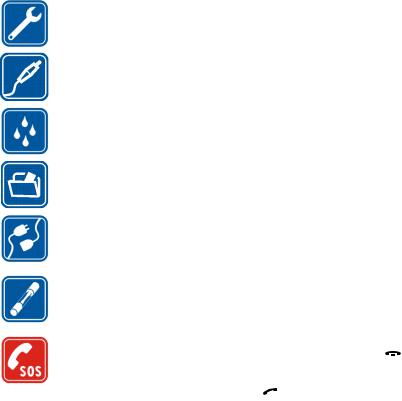
QUALIFIED SERVICE
Only qualified personnel may install or repair radio equipment.
ACCESSORIES
Use only approved accessories. Do not connect incompatible products.
WATER-RESISTANCE
Your radio is not water-resistant. Keep it dry.
BACKUP COPIES
Remember to make backup copies of all important data.
CONNECTING TO OTHER DEVICES
When connecting to any other device, read its user's guide for detailed safety instructions. Do not connect incompatible products.
FUSE REPLACEMENT
Replace a blown fuse with a fuse with of the same type and size. Never use a fuse with a higher rating!
EMERGENCY CALLS |
|
Ensure the radio is switched on and in service. Press |
as many times as |
needed (e.g. to exit a call, to exit a menu, etc.) to clear the display. Enter the
emergency number, then press |
. Give your location. Do not end the call |
until told to do so. |
|
■ Network services
The radio described in this guide is approved for use on the TETRA network.
A number of features included in this guide are called Network Services. These are special services that you arrange through your wireless service provider. Before you can take
Copyright © 2005 Nokia. All rights reserved. |
18 |

advantage of any of these Network Services, you must subscribe to them through your service provider and obtain instructions for their use from your service provider.
Note: Some networks may not support all language-dependent characters and/or services.
■ About accessories
Warning: Use only accessories approved by the manufacturer for use with this particular radio model. The use of any other types may invalidate any approval or warranty applying to the radio, and may be dangerous.
For availability of approved accessories, please check with your dealer.
When you disconnect the power cord of any accessory, grasp and pull the plug, not the cord.
Copyright © 2005 Nokia. All rights reserved. |
19 |

General information
■ Access codes
PIN code (4 digits)
The factory setting for the PIN code is 1234. To prevent unauthorised use of your radio, change the code in the submenu of the Settings menu. Keep the new code secret and in a safe place separate from your radio.
When the PIN code request is enabled (see |
on page |
), the |
code is requested each time the radio is switched on. |
|
|
Security code (5 digits)
107
The factory setting for the security code is 12345. To prevent unauthorised use of your radio, change the code in the submenu of the Settings menu, see Security settings on page 107. Keep the new code secret and in a safe place separate from your radio.
■ Conventions used in this guide
Change of access codes
The display texts next to the selection keys and are indicated in a bold typeface, for example, Menu. The other display texts which appear on the radio’s display are indicated in italics, for example, Calling. All key presses are
Copyright © 2005 Nokia. All rights reserved. |
20 |
Security settings
Change of access codes

represented by the graphic of the corresponding key, for example, by |
|
and |
|
||
. |
|
|
■ Modes of operation
Your radio has two modes of operation: network mode and direct mode. In network mode, the radio operates via the TETRA network. In direct mode, the radio operates without the network, so the radios are communicating directly with each other. In direct mode only some of the radio’s functions are available. See Direct mode on page for more information about direct mode.
■ Shared memory
The following features in this radio may share memory: contacts, calendar, and 66
to-do notes. Using any such features may reduce the memory available for any features sharing memory. This is especially true with heavy use of any of the features (although some of the features may have a certain amount of memory specially allotted to them in addition to the amount of memory shared with other features). For example, saving many names or notes may take all of the shared memory and your radio may display a message that the memory is full. In this case, delete some of the information or entries stored in the shared memory features before continuing.
Copyright © 2005 Nokia. All rights reserved. |
21 |

■ Transmission barring
When transmission barring is active, the radio does not send any signals to the network and only limited network services are available. In network mode, the radio can only receive group calls and status and text messages addressed to talk groups, providing that the radio is registered to the network. In direct mode, the radio can receive direct mode calls. Note that when transmission barring is active, the radio cannot re-register to the network, for example, if it is switched off and then on again.
Note: The limited network services in network mode are only available in the coverage area of the network cell where the radio was last registered. The radio cannot register to other network cells while transmission barring is active, and therefore the area of operation may be limited.
When transmission barring is active, in network mode the radio cannot send the necessary information to the network about changes in talk groups. When transmission barring is active, you cannot change the selected group. If you make any other changes that affect talk groups, for example, change the selected folder, home group or the scanning priority of a group, you will not be able to receive further communication from the affected groups. After transmission barring has been deactivated, the radio can attempt to negotiate the changes with the network.
If you start to make a red key call or an emergency call to the emergency number programmed into your radio when transmission barring is active, the radio will automatically deactivate transmission barring and attempt to make the call. See also Red key calls and emergency calls in direct mode on page
Copyright © 2005 Nokia. All rights reserved. |
22 |
71
.

Note: If you start to make a red key call or an emergency call when transmission barring is active, transmission barring will be deactivated, and you should consider exiting the area where you wanted transmission to be barred.
See Transmission barring on page
transmission barring. Note that transmission barring should be active before you enter the area where you want transmission to be barred. The indicator  or
or  is displayed in standby mode when transmission barring is active. Depending on predefined radio settings,100 the radio may send a notification message to the network about the activation. The indicator
is displayed in standby mode when transmission barring is active. Depending on predefined radio settings,100 the radio may send a notification message to the network about the activation. The indicator  is displayed if the message does
is displayed if the message does
for how to activate or deactivate
not need to be sent or message sending failed, and the indicator is displayed if the message has been sent.
■ Network selection
Next to your predefined home network, you may be able to select other networks in which your radio can operate (network service), for example, if you are not in the coverage area of your home network. The network can be changed automatically or manually, see Network selection on page .
Note: Some services are network-dependent, so there may be changes in the availability of services when the network is changed. In addition, for example the selected folder, selected group, home group, or availability
104
of groups may change when the network is changed.
Copyright © 2005 Nokia. All rights reserved. |
23 |
■ Special features
The Nokia TMR880 radio offers some special features. One of the back panel connectors of the radio has programmable input/output pins, for example, for connecting external devices such as a status panel. It is also possible to connect enhancements to the system cable (SCR-14), for example, an external GPS (Global Positioning System) device. In addition to the standard AT commands, the Nokia TMR880 radio supports an extended AT command set for controlling the radio.
For details and availability, contact your service provider.
■ Control unit
A separate Nokia Control Unit (CUR-2) can be connected to the Nokia TMR880 radio. For example, it can be used as a second control unit or installed in places where space is limited. The Nokia Control Unit has connectors for a speaker microphone and a helmet enhancement (for example, for use with motorcycles). With the helmet enhancement, it is possible to mute all other audio enhancements that are connected to the Nokia Control Unit and the Nokia TMR880 radio.
For details and availability, contact your dealer.
Copyright © 2005 Nokia. All rights reserved. |
24 |

1. Getting started
■ Switching the radio on and off
1.Press and hold  to switch the radio on and off.
to switch the radio on and off.
2.If the radio asks for a PIN code, key in the four-digit PIN code (displayed as ****)
and press OK.
3.If the radio asks for a security code, key in the five-digit security code (displayed as *****) and press OK.
For more information on the codes, see Access codes on page
Warning: Do not switch the radio on when wireless phone use is prohibited or when it may cause interference or danger.
Caution: In order to comply with RF exposure requirements for mobile
20
transmitting devices, a minimum distance of 20 cm must be maintained between the antenna and all persons. .
Note: The radio will not work unless sufficient power is supplied through a power source, e.g., a vehicle’s battery.
■ Ignition sense
If the radio is installed in a vehicle, the ignition sense feature can be installed to prevent the radio from draining the vehicle’s battery. The ignition sense enables the radio to be automatically switched on or off approximately 20 seconds after
Copyright © 2005 Nokia. All rights reserved. |
25 |

the ignition key of the vehicle has been turned on or off. However, you can switch the radio on or off at any time with the  key.
key.
When the ignition key is turned off, the text Phone will power off, if not used is displayed. If you press any number key, the radio will not be switched off.
■ Locking the keys (Keyguard)
Your radio has two levels of keyguard.
• Keypad locks the keypad keys except for the volume keys,  ,
,  and the red function key
and the red function key  .. To activate this keyguard, press Menu and then press
.. To activate this keyguard, press Menu and then press 
 within 1.5 seconds. The note Keypad locked
within 1.5 seconds. The note Keypad locked
•All keys locks all the keys of the radio except the volume keys, the red function key  and the back key. To activate this keyguard, press Menu and then press
and the back key. To activate this keyguard, press Menu and then press
and hold |
within 1.5 seconds. The note All keys are locked is briefly |
|
displayed. |
|
|
• To unlock either keyguard, press Unlock and then |
within 1.5 seconds. |
|
is briefly displayed.
You can answer a phone call and respond to a group call or an express call when either keyguard is on. When the call ends, the keys are automatically locked.
See also Keyguard settings on page
Note: When Keyguard is on, calls may be possible to the emergency number programmed into your radio (e.g. 112 or other official emergency number). Key in the emergency number and press  . The number is displayed only after you have keyed in its last106digit.
. The number is displayed only after you have keyed in its last106digit.
.
Copyright © 2005 Nokia. All rights reserved. |
26 |
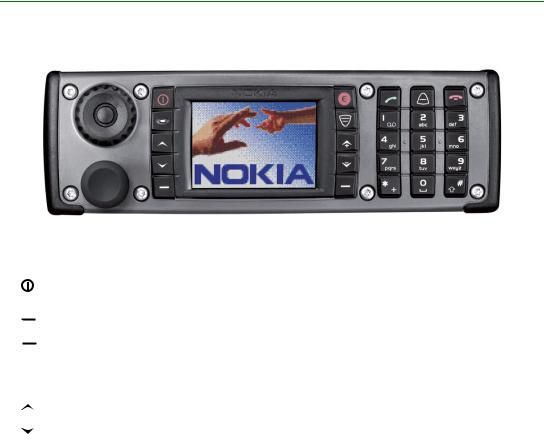
2. Your radio
Power key. Switches the power on and off.
Selection keys. The function of the keys depends on the guiding text shown on the display next to the keys, for example, Menu and Contacts in standby mode.
Scroll keys. Use these keys to scroll through names, phone numbers and menus. In network mode, pressing  in standby mode enters the list of folders and pressing
in standby mode enters the list of folders and pressing  enters the list of talk groups in the selected folder.
enters the list of talk groups in the selected folder.
Copyright © 2005 Nokia. All rights reserved. |
27 |
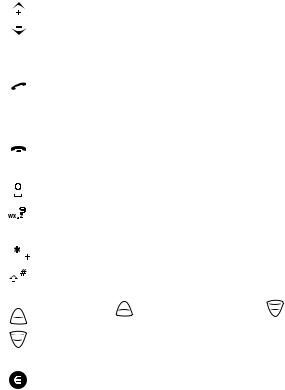
Volume keys Pressing  increases the volume and pressing
increases the volume and pressing  decreases the volume. See also Muting external
decreases the volume. See also Muting external
loudspeakers on page
Dials and answers a phone call. In standby mode, shows the list of the most recently dialled numbers.
33
Ends or rejects a phone call or an express call.
.
Enter numbers and characters.
Used for various purposes in different functions.
|
Duty key |
|
and fast menu key |
. See Duty key and fast |
|
|
menu key on page . |
|
|||
|
Red function key. See |
on page |
|||
|
|
33 |
|
Red key calls |
|
■ |
Types of calls |
|
|||
|
|
||||
|
|
|
|
|
29 |
• Group calls are immediate communication between talk group members. For |
|||||
|
details, see Group calls on page . |
. |
|||
46 |
© 2005 Nokia. All rights reserved. |
28 |
Copyright |

•Express calls are immediate communication between two people. For details, see Express calls on page
• Phone calls |
Phone calls |
on page |
|
These call types are available in network mode. Your radio also offers direct mode 59
operation (see Direct mode on page ).
.
62
Redarekeylikecallsconventional telephone calls. For details, see
.
The red key call in network mode is a network service. Before you can take
66
advantage of this network service, you must subscribe to it through your service provider and obtain instructions for its use from your service provider. The red key call
network mode, when you press and hold the red function key  , the radio will
, the radio will
is made to a destination that has been defined by your organisation. In
attempt to make a red key call. When you press the red function key and then the back key, the radio will attempt to make a silent red key call. See also Red key calls and emergency calls in direct mode on page 71
If you do not have a handsfree microphone installed. but are using a speaker microphone (see Speaker microphone on page
PTT key when you start speaking.
If the radio receives a red key call ,or a call made to a destination that is predefined as an emergency number, the radio plays a tone and Priority call is displayed with the call information. 32
), you need to press and hold the
Copyright © 2005 Nokia. All rights reserved. |
29 |
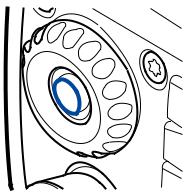
■ Group selector and back key
In network mode, turning the group selector is used for selecting groups. The names of the current folder and group are shown on the display.
The back key in the middle of the group selector is used for switching between groups. Pressing the back key switches between the groups that have the same index number as the last two selected groups (excluding the home group), and pressing and holding the back key selects the home group (see Home group on page
In direct mode, the group selector is used for selecting channels. The name of the channel is shown on the display. Each channel may have up to three groups. Pressing and holding the back key selects the first group (A) on the channel, and
47
pressing the back key switches between the second and the third group (B and C) on the channel. ).
If voice feedback is activated, the radio plays the index number of the group or channel when you turn the group selector. When you use the back key, the radio plays the index number or index name (A, B, or C) of the group or "Home" if the home group is selected. See Voice feedback on page .
■ The PTT (Push-To-Talk) key
Your radio can make and receive one-way and two-way calls. During a one-way 45
call, only one person can speak at a time and the speaker has to press and hold the
Copyright © 2005 Nokia. All rights reserved. |
30 |
